If you are a nature-loving traveler and faced with the decision of choosing your next destination, consider the key differences between Iceland and Norway. Both are expensive and best visited during summer. Choose Iceland for easy road trips with diverse landscapes, while Norway is ideal for extensive road trips and majestic hiking adventures.
What should you visit next – Iceland or Norway?
As a true traveller and nature lover, you are now faced with the decision of choosing your next destination.
If you could, you would probably choose to visit both of these countries. But the issue is that they both require at least ten days to visit, are some of the most expensive places on Earth and are cold most of the time, so you need to plan your trip accordingly.
Obviously, these are not holiday destinations if you struggle to find $1000 in your bank account at any given time.
During July and August is when both Iceland and Norway get crowded (considering their touristic capacities) and the prices skyrocket (if that’s even possible, but it is).
After visiting both of these places, staying and doing road trips in both Norway and Iceland for over a month, I have first-hand experience, and I can tell you all about my experience in these gorgeous countries.
Hopefully, this post comparing Iceland vs Norway will help you make the right decision.
It is not meant to deter you from visiting one or the other, but more to help you decide which of the two countries should you visit first.
As a digital nomad and travel blogger, I am blessed with the flexibility to spend more time in a country and chase all the outdoor activities I want, regardless of the day or period of the year.
So, from that perspective, I’ll try to offer you one of the most complete overviews of Iceland and Norway, compare the two from all perspectives and leave no question unanswered.
So let’s talk about everything about Norway vs. Iceland, from fjords and hot springs to alcohol consumption, ferries, transportation, and activities. Ready? Get a cup of coffee (tea, hot cocoa or any other drink of your choice) because it’s gonna be a long one.
Iceland vs Norway: geographical overview
Let’s talk geography.
It’s no surprise that tourists in Iceland and Norway choose these holiday destinations because of their breathtaking natural landscapes. It’s all about fjords, natural hot springs, mountains, and, of course, the Aurora Borealis.
Both Norway and Iceland are somehow located in the Arctic Circle. Both are part of Scandinavia.
So let’s look at the map a bit to explain some of the differences that might affect your travel decision-making or travel plans.

Here are some top differences between Norway and Iceland
Geographical size/location
- Iceland is an island and can only be reached by ferry (departs from Denmark, with a stop on the Faroe Islands and takes three days) if you want to bring your car (will cost you about 2,500 EUR road trip) or by plane (which is what most people use.
- Norway is part of the Scandinavian peninsula and can be reached by car from any other part of continental Europe.
- Iceland is much smaller than Norway. Most people choose to spend around one week to 10 days in Iceland, which is plenty to see the top attractions and some more.
- Norway is a super long piece of land, and it requires at least ten days (for the bottom half). If you want to see more of it, then 2-3 weeks will be needed at a minimum. Take into account that the distances between attractions in Norway are huge, and you’ll spend a lot of hours during the day just driving.
- Norway is all about fjords and mountains, and it offers lots of hiking opportunities (mostly suitable during warmer months).
- Hiking in Iceland is more limited, and there are only a handful of hikes accessible for the majority of us.
- Iceland has plenty of geothermal spots, resulting in countless accessible public pools (and other more popular spots, but more expensive, such as the Blue Lagoon).
- Norway has no hot springs (except for one in the Lofoten Islands).
Best way to visit Norway and Iceland
The best way to visit both countries is by doing a road trip.
The advantage is that you can road trip around Iceland (by doing the Ring Road, which circles the entire island); in Norway, you will go from South to North, and you will need to go back more or less the same way if you need to get to your starting point.
Norway has superb roads and one of the best infrastructures in the world. And when the road stops, they have ferries connecting the European roads because they’re more efficient and don’t ruin the landscape.
Iceland has cheap electricity because of the geothermal power plants, but it’s still building a lot of its infrastructure.
If you want to explore more and add more adventure to your Icelandic trip, then you want to plan to drive in the highlands (inner part of Iceland), which is solely made of mountainous terrain and F roads (rough dirt roads that don’t look like roads and sometimes cross rivers).
Normal cars are forbidden to drive on those, and you’ll need to rent a 4WD car to go there (this can be checked with the car rental company, as they all clearly specify this aspect).
Arctic Circle
Both countries have a part of their territory in the Arctic Circle.
Since the Arctic Circle is moving, the only part of Iceland in the Arctic is a small part of Grimsey Island, a remote island in the North. Norway had about a third of its territory in the Arctic and one big Arctic Circle centre.
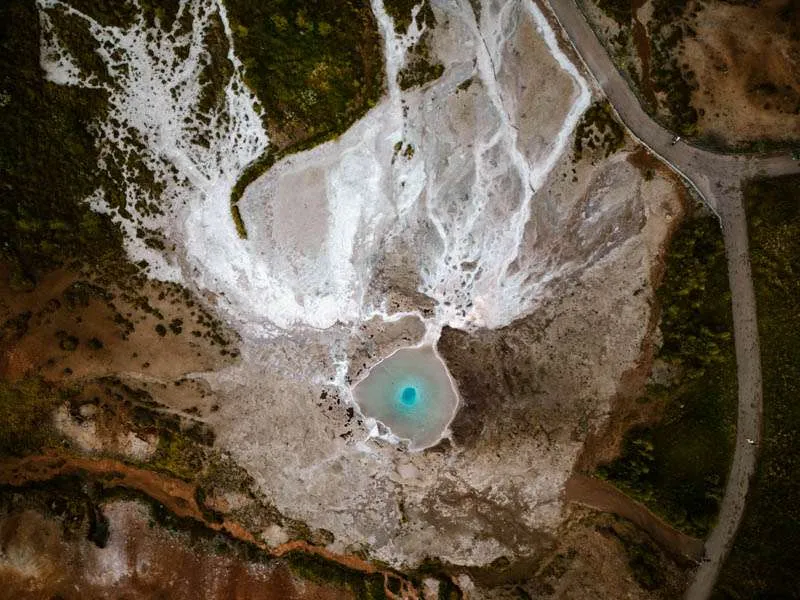
Iceland vs Norway: natural wonders, adventures and activities
Outdoor activities available in Iceland and Norway:
- Boat tours to see whales and dolphins (North Iceland and North Norway)
- Puffin sightseeing (June and July in Iceland). These beautiful birds can only be seen during the summer months in Iceland when they form nests on the cliffs during mating season.
- Ice caves (winter months, in glaciers)
- Northern Lights (September to May, can be seen from both Iceland and Norway)
Hot springs

Iceland is known for its geothermal hot springs.
There are literally everywhere, and almost all towns and villages have a public swimming pool with hot tubs.
That’s one of the reasons it’s so easy to go camping in Iceland or just rent a camper for a week and sleep in it. Because you can go to such a public swimming pool daily, and the entry fee is super accessible.
Norway doesn’t have a lot of hot springs. In fact, there’s only one, but considering the size of the country, it’s like it doesn’t exist.
Mountains and fjords
Iceland
Iceland is like a piece of lava rock in the middle of the North Atlantic Ocean.
The areas around the main road have a few mountains, but it’s mostly flat. The views are stunning, not going to argue, but there aren’t a lot of mountains. On the East side of Iceland, you’ll get to drive around a few fjords, which are impressive.
The downside is that there is only one road and not many stops and viewing points.
So basically, everyone stops in the same place, and since there is always limited space, you might not be able to park there.
However, most of the spots were ok for me. That’s also why I recommend renting a car for visiting Iceland.
That way, you can have a place to yourself and not get lost in the crowds of the bus tour.

Norway
Norway, on the other hand, is world famous for its fjords, which are in the thousands. Basically, the entire West Coast, from South to North, is sprinkled with gorgeous fjords. The most famous Norwegian fjords are in the bottom half of the country, so here is where you will find the larger crowds coming from road trippers, tour buses and cruise ships.
However, the fjords in Norway are huge, offer plenty of viewing points on all sides, and you’ll have no issue finding a spot just for yourself.
What I truly loved about these majestic fjords is that one day, you can drive on top of the fjord and take in all the beautiful views from above, and the next day, you can experience the same fjords from the ferry crossing through it.
There’s nothing like it, and these are some of my most cherished memories from my epic 1-month trip in Norway.
Obviously, these huge fjords and mountains are home to some of the most beautiful hiking trails in the world. If you are into hiking, I can’t recommend them enough. Please check out my itinerary for doing all these popular hikes in Norway.
Glaciers
Both Norway and Iceland are home to the largest glaciers in Europe. And they both have more than one glacier.
Norway
Norway has the Jostedalsbreen glacier, which is the largest glacier in Continental Europe.
Note that when we talk about glaciers, we often refer to different glaciers’ arms (different parts of them).
This is because these glaciers are huge, and you can only see one part of it at a time. In some cases, you can even visit them by going on different hikes which allow you to get closer, or by going on organised tours to walk on the glacier (you should never go hiking ON THE GLACIER on your own!)
So, in Norway, you can see multiple glaciers. Go on tours if you want to walk on a glacier, and there are many different hikes you can do on your own, each with a different difficulty level, to see the glaciers.
I did two hikes in Norway around two different glaciers, and they were both worth it.
One was very easy (Briksdalsbreen Sightseeing Spot in the Jostedalsbreen National Park), and one was medium level (Buerbreen in the Folgefonna National Park).
And don’t worry if you are not into hiking. You will see the glaciers in Norway, even from the main road, as you are driving past them.
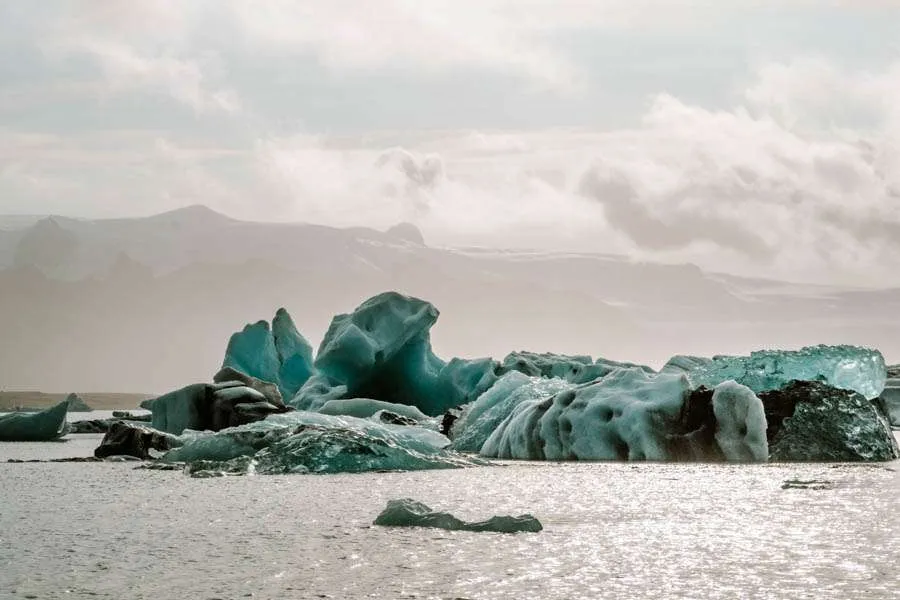
Iceland
In Iceland, you will also get to see glaciers.
In fact, one of the most popular attractions in Iceland is the Vatnajökull National Park, with its one and only Jökulsárlón Glacier Lagoon.
This is the place where pieces of the huge glaciers are slowly melting and drifting away into the ocean. This is one of the most popular and crowded places in Iceland, and it is accessible all year long. It is only 5 hours (driving) from Reykjavik).
In fact, since this is so popular, and on the other side of the road you have the world-famous Diamon Beach, tour agencies offer many different activities here.
Top activities involving glaciers
Here are the top activities in the area, which everyone will be doing and are to book in advance:
- Amphibian boat tour (all year long)
- Zodiac boat tour (all year long)
- Blue cave guided tour (November to April)
- Day trip from Reykjavik with boat tour (this is the best option if you’re not renting a car to get there)
- Walking on the icecap (tour provides crampons and ice axe)
So, if you’re planning to visit the Jökulsárlón glacier lagoon, I strongly recommend that you book a boat tour before you get there (it gets fully booked in summer, and July especially is crazily crowded).
Hiking and adventure activities
Iceland
Iceland is famous for its otherworldly landscapes, such as erupting volcanoes.
However, most tourist spots are just next to the main road. You don’t have to go hiking for long to see all those places you’ve seen all over social media. If it’s a very popular place, it will probably have a huge parking lot right next to it and possibly public toilets.
For instance, next to the Geysir in Iceland, you have a huge parking lot, a huge souvenir shop, a cafeteria, and a really nice hotel for free. And this is all just across the street from the world-famous geyser of Iceland.
As for hiking in Iceland, there are some popular hikes of medium difficulty around the country, but the truly stunning hikes are in the highlands, and you will need to rent a 4WD to get to one of the starting points of the trail. Or you can arrange with a tour company to drop you off and then pick you up at the other end at a certain time.
For instance, the most popular and praised hike in Iceland is Landmannalaugar, but if you want to do the whole thing, expect to spend four days camping in the highlands, where the weather is far from friendly.
However, you can do a few day hikes, such as Mosfellsbær (popular with locals in Reykjavik) and Glymur Waterfall.
So, I find that hiking in Iceland is more accessible (during summer), and hikes are shorter. Almost all these popular hikes can be done as a day trip from Reykjavik if you have your own car.
Norway
Norway, with its many fjords, offers countless hiking opportunities. I did the most popular hikes in just about a week, and I wrote the perfect itinerary for doing the most popular hikes in Norway.
Since Norway is much larger than Iceland, planning for all these adventures and hikes is necessary, as the distances are huge between them, and logistics play a huge role in being able to fit everything into a reasonable schedule.
If you don’t plan for it, you might find that the parking is full (if not pre-booked), and the ferry can’t take you because it’s full or doesn’t work that often. Accommodation options are also limited near popular hiking spots.
For some hikes in Norway, you can get on a bus trip to get you there.
This is the case for Preikestolen, the absolute most popular hike in Norway. The bus will take you from Stavanger to the starting point of the hike and then back to the city. Many tour agencies offer trips around Stavanger (btw, this is one of my favourite cities in Norway).
But for the other hikes, you will need to find a way to get to the city next to the starting point of the hike on your own. And, as I said, distances are not small. I spent about half a day to a whole day driving between different hiking spots.
Norway is also home to the North Cape, the Northernmost spot in continental Europe. I drove all the way from South to North in Norway.
I wrote the perfect itinerary for reaching the North Cape in Norway, which you can use if you don’t want to miss any of the top attractions in Norway.

Volcanoes
Since 2021, Iceland had at least one volcanic per year.
I know it sounds scary, but the Icelandic authorities are fully prepared to handle these events.
When I travelled to Iceland in the summer of 2023, I woke up one morning to quite a frightening Earthquake.
Only a week later, a new volcano erupted, and after a few days, tourists were allowed to hike to the site and see it in real life.
That was one of those once-in-a-lifetime experiences. I wrote all about that, including how to access the site, in this Iceland volcano eruption 2023 guide. According to local sources, the entire Reykjanes peninsula is expected to have more erupting volcanos in the future. While nobody knows when the next volcano will erupt, always follow the advice of local authorities and be safe!
This is the only chapter of this “Iceland vs Norway” comparison where Norway falls short. There are no volcanos in Norway.
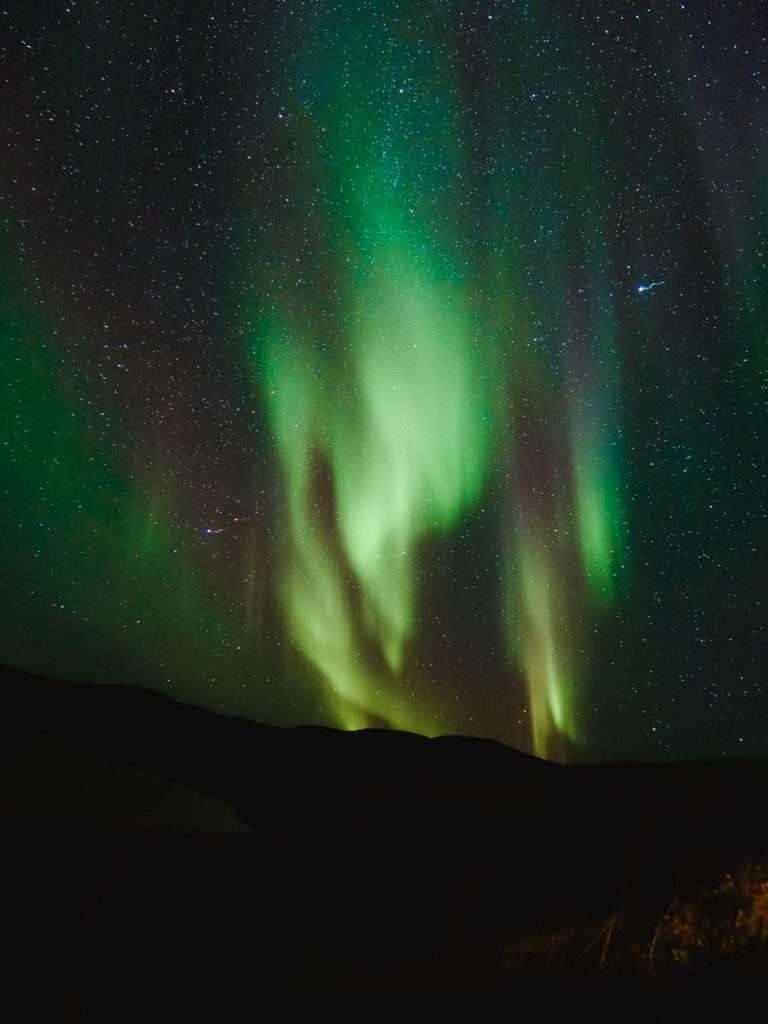
Northern Lights
One of the most popular things to do anywhere in Scandinavia is to chase the Northern Lights.
Let’s set some expectations here about when you can see the Northern Lights:
- It needs to be dark outside, with a clear sky (no clouds)
- It needs Aurora activity (some days are quieter than others; check the specific apps)
- To get a better view, you need to go outside of cities because city lights might make it harder to observe the phenomena.
The famous Aurora can be seen from both Norway and Iceland if the above conditions are met. If you are lucky, you might even see it from your hotel window. In Northern Norway, I saw the Aurora at the end of September a couple of times.
Statistically speaking, there are times when there is more aurora activity than other times, but a huge issue is the clouds. As you can imagine, it’s pretty cloudy in those places during the cold season.
So that’s why so many tour agencies offer this Aurora hunting. They offer to pick you up on a bus and then drive you around until they find a cloud-free spot for you to observe the phenomena.
They probably know the place better than you will ever know, so if you’re short on time, you are keen on seeing the Aurora and the forecast is cloudy, then it might be worth a shot to book one of those tours. These tours are offered in both Norway and Iceland.
However, Norway is a much better spot to see and chase the Aurora. That is because it’s much larger, and the Northern part is much smoother than Iceland.
Iceland is a rock in the ocean, so it’s expected that it will be covered in clouds a lot of the time.
Transport and accessibility
To make the best of Iceland and Norway, you will need to rent a car.
In both countries, you will find tour agencies offering day trips and or multi-day trips to the popular spots. But you will not find a tour offering everything there is to see on that itinerary, and it will be on a bus with a bunch of strangers. These tours are also a sort of sightseeing on fast-forward.
In Iceland, there are also some buses connecting different cities during summer. During winter, I couldn’t find any kind of public transport on the East Coast. However, renting a car it’s up to you and you can also travel to Iceland without renting a car.
Norway has many more roads, and it’s much better connected.
Both countries have secondary roads which are not open during winter.
This is an issue in Iceland, which doesn’t have many road alternatives to begin with. Some roads in Iceland have special signs on them saying that if you drive there during winter, you might get stuck and calling for a towing service is expensive (not a joke).

Driving
Norway has plenty of roads, tunnels and ferries.
It’s fairly easy to drive in Norway, but I do recommend it for more experienced drivers, especially on top of the fjords and in National Parks where roads are narrower. Check out my ultimate 10-day Norway itinerary to get an idea.
Iceland only has one road that circles the island, called Ring Road, with very few other smaller roads to get you to certain extremities. Here’s my ultimate Ring Road itinerary in Iceland (it can be easily extended to add more stops and days).
Most of these small roads in Iceland can be dirt roads and are not advisable during colder months when it snows.
If you want to do a road trip, the summer season is the time to go. You’ll be surprised to discover that Iceland is actually very green.
Gas is expensive in both countries, but it’s a bit more expensive in Iceland.
However, you will easily find petrol stations (gasoline and diesel) everywhere. Norway is super friendly to electric vehicles, and you will find charging points literally everywhere. If you have an electric car and want to go on a road trip, go to Norway.
Airports
Iceland’s main airport is Keflavik, which is just about 45 minutes away from Reykjavik, the capital city. The country’s second-largest city, Akureyri, located in North Iceland, also had an international airport.
But a lot of smaller towns in Iceland also have tiny airports, and you will find regular domestic flights between different locations. Since the entire island is pretty remote and it might take a while to get somewhere, choosing a domestic flight might be worth considering.
In Norway, you will find plenty of international airports in all major cities.
The most popular is Oslo Airport, but depending on your travel plans and activities, you might want to fly to Oslo, Stavanger, Bergen, Trondheim or Tromso. There are also many smaller airports for domestic flights, but this is no wonder considering the size of the country and the difficult mountain roads.
Ferries
Iceland
Iceland has a few ferry services between the main island and its smaller island, such as Grimsey in the North (which is the only place in Iceland located in the Arctic Circle) and Vestmannaeyjabær in the South.
Iceland is also connected to mainland Europe by a 3-day ferry service, which runs about twice a week during the summer months.
Other boat activities are offered by the multitude of tour agencies offering whale-watching boat tours, especially in the North.
All these ferries must be pre-booked, and getting your car onboard will be extra expensive and cannot be done without an online booking.
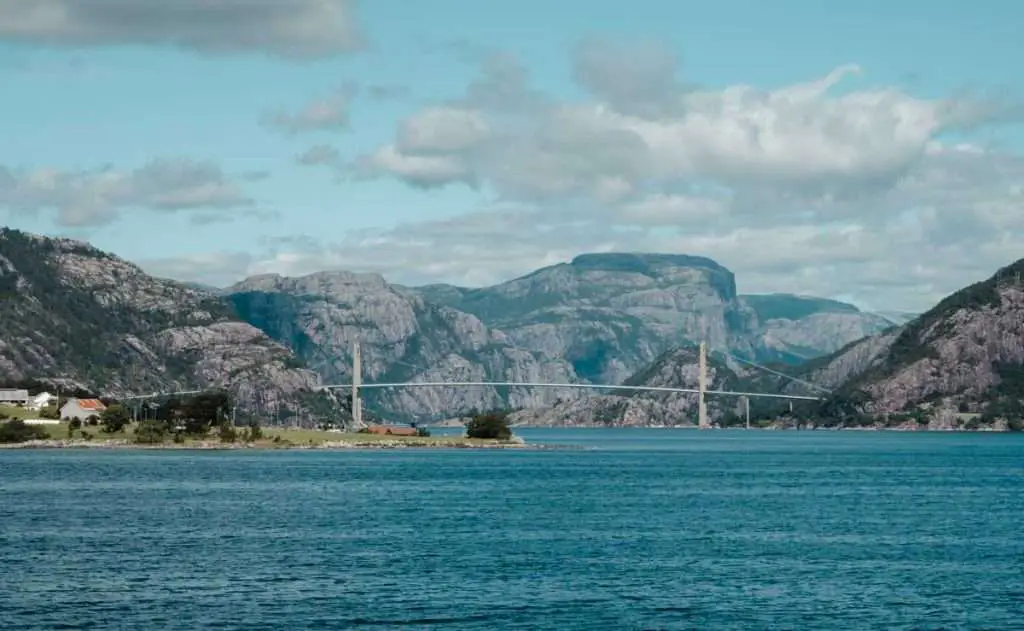
Norway
Norway is famous for its ferry services, which are more than I could count.
Many roads are cut off in between fjords in Norway, and short, non-stop ferry services connect those roads. Most of these ferries don’t require pre-booking. You just show up and wait in your appropriate queue (cars, campers, trucks, etc) for the ferry to arrive.
If you are doing a road trip in the bottom half of the country (from Trondheim to Stavanger, for instance), you will get used to those ferries, which is the Norwegian solution to connect European roads where bridges or tunnels wouldn’t have worked.
Some of these ferries are free, some are operated by the road authority, and you will automatically pay the toll via their electric system (get the ePass24 app), and some will ask you to pay on the spot before boarding or after you get off.
These are not cheap, and these fees will quickly add up to hundreds of dollars. Check out my dedicated Norway travel guide for more details.
I find that the most expensive ferries are the ones that can also be considered touristy, such as the ferry on the Geiranger Fjord, which is one of the two UNESCO fjords in Norway.
This is a big enough ferry to also fit cars. It didn’t require an online booking (I was there in July), but it was over $100 for a car and two passengers.
Other much smaller ferries only run on certain days, according to the season or have a very limited capacity and require an online booking at least a week in advance, as was the case with the ferry on Lysefjord.
I strongly suggest that you carefully craft your Norway trip itinerary and research all ferries that leave from small places. But if it’s a bit town, it’s not an issue.
Culinary experience
Food in Scandinavia tends to be more bland and simple.
A lot of the dishes are meat-based, with a side dish of potatoes or something similar. But all of these places have a strong fishing culture.
This makes sense, considering their ancestors were mostly fishermen and Vikings (some sort of pirates of the sea).
I am not a foodie, and I don’t eat meat either, but it wasn’t difficult at all to find ready-to-eat meals wherever I went, which is all over Scandinavia and Iceland.
You will find meatballs in different combinations, and fish, especially codfish, is very popular.
Things like bread, butter, eggs, and cheese are very popular and can be found everywhere.
But don’t worry if you don’t like these things. It’s fairly easy to find international food too, even in remote places in Iceland. Those places seem remote, are indeed remote, but have everything you need wherever you go.
I find that Iceland has a lot of American influences when it comes to food.
Norway is more Nordic, serving fish in any shape and form everywhere you go (I was offered picked herring in all hotels in Norway, no matter the size of the place).

Eating out and cooking my own meals
However, eating out is expensive.
The most basic meal, something like a fast food meal or similar, will cost you around $10-15 and might not be enough. Eating in a cheap restaurant will cost you about $20-30, with a drink included.
Iceland is the most expensive place to eat out.
Since Norway is much bigger, you can find affordable alternatives, but it also depends on your luck and location.
In both Norway and Iceland, you can easily cook your own meals because most casual accommodations have a kitchen.
In Norway, I stayed in a bunch of apartments which were built specifically for tourists. Also, you will find a lot of cabins with a cooking area in a lot of campsites.
In Iceland, most budget accommodations are similar to hostels, with a shared bathroom and kitchen. All were very clean and functional.
I cooked a lot of my meals and would often make lunch boxes for the day before leaving my accommodation. And this is what most people were doing.
The bottom line is that I did not starve; quite on the contrary.
Alcohol
Selling of alcohol and consumption has a special status in Scandinavia and Iceland.
Unlike in many other countries from around the world, alcohol is sold in state-controlled liquor stores in Norway, Iceland, Sweden, the Faroe Islands and Finland. These stores have different names in each country. This is called a government monopoly on the sale of strong alcohol.
Basically, if you want to drink any alcoholic drink that has more than 1-2% alcohol, you need to visit these stores:
- Vínbúðin – Iceland (must be over 20)
- Vinmonopolet – Norway (must be over 18 for buying wine and beer, and over 20 for spirits)
The more alcohol a drink has, the more taxes have, and therefore, the more expensive it is.
However, these stores are just like regular supermarkets, often located in the vicinity of supermarkets, and I didn’t find any restrictions on buying alcohol in Iceland or Norway.
If you look very young, the cashier might ask for an ID to make sure you are above the legal drinking age.
Note that these stores often have more limited opening hours than regular supermarkets, and close earlier on Saturday and are mostly closed on Sundays.
Prices are higher than in any other European country, and Iceland is the most expensive country to buy alcohol.
An important tip for buying alcohol in Iceland and Norway
If you decide to travel to Iceland, you have the opportunity to buy alcohol duty-free at the airport, which is right next to the baggage claim area (after the “Exit to Iceland” sign, down the stairs).
Prices in that duty-free store are almost half of what you will find in most liquor stores. A lot of tourists and locals buy lots here. If you like to enjoy a beer now and then and have a rental car waiting for you outside, then this is the place to stock up. There is a limit for buying alcohol, but it’s pretty high, and it correlates to the alcohol percentage of the chosen drinks.
If you are driving to Norway, buy your alcohol before you get there. A lot of Norwegians go to Sweden to stock up on alcohol. I am talking about filling up the car.

Accommodation and hospitality
Both Norwegians and Icelandic people are extremely hospitable and friendly.
I was genuinely surprised by the warmth of all these people welcoming us into their Airbnbs, guesthouses and campsites.
Obviously, big chain hotels are the least personal, but those were still very pleasant stays.
Norway
I have tried all kinds of accommodations in Norway, from camping in a tent to staying in a 4-star hotel. There you will definitely find accommodation to suit your budget.
However, if your budget is lower and more strict, I strongly advise you to book accommodation in advance, especially if you are travelling during the summer months. All budget-friendly places are often booked six months in advance.
Norway has loads of campsites scattered all over the country. That’s because they have a strong camping culture, and that’s their preferred way to spend their summer holiday.
Note that a lot of people in the Nord tend to take a month-long holiday during summer, in July or August, and all places are fully booked months in advance. If you’re travelling outside these months, you might have a much better chance to find affordable accommodation on the spot. But the weather won’t be as good.
Free camping is still allowed in Norway, but common sense rules apply.
Iceland
In Iceland, free camping is now illegal. Thanks to reckless tourists who don’t have the common sense to clean up after themselves and leave no trace of their stay. Iceland is especially protective of its fragile nature and has strict rules about this.
However, you will find a lot of campsites and hostels near most tourist places. But given the size of the country and the huge number of tourists during summer, I also recommend booking accommodation in advance to make sure to get the best deals.
The good news is that most places in Norway and Iceland have 5-star reviews, and those places live up to their description and expectations. In their societies, the concept of cheap or badly-made doesn’t seem to exist.
And that is a breath of fresh air, knowing that you will not be cheated and will get a great place to stay, even if it’s a budget place.
Cost and budgeting
Vising any of the Nordic countries is not cheap—quite the contrary.
But the bright side is that you do get what you pay for; all services are immaculate and well worth it. You will not feel cheated.
You need to understand that you will travel to some of the most remote and civilised places on the planet. You’ll get to witness unthinkable displays of the miracles of nature and then spend the night in modern hotels which offer the best amenities you can think of. This is not a small thing.
Here are some basic costs you need to consider before travelling to Norway or Iceland. (average prices)
- Hotel room – $100 per night
- Gas – $2 per litre
- Car rental $100 per day
- Meal for one – $30
- Day trip/tour – $100
- Flights – depends on where you’re flying from, probably about $500 – $1000 (cheaper if you’re flying from Europe)
For a really detailed explanation of how much I spent during my trip to Iceland, check out this post about how much it cost a month in Iceland for two.
I’ve already mentioned a bunch of tips on how to keep your costs down when travelling to Norway or Iceland.
How to save money
But here are my top tips to save money in Scandinavia:
- Book your car rental as soon as possible (this is the biggest cost of your trip)
- Book hotels in advance (to find the best prices)
- Create an itinerary and pre-book any parking, ferries, and day trips if necessary (mostly for Norway)
- Sign up for airlines, tour agencies, car rentals newsletter, follow them on social media and hunt for any discounts (this needs to be done up to 1 year in advance)
- Consider staying longer. I stayed for more than one month in Iceland, and this gave me time to visit and rest. It also cuts down accommodation costs when you book a place for a longer time.
Best time to visit
Most people choose to visit Iceland or Norway during the summer months (July or August).
That’s when the weather is most agreeable for most of us, especially for people now used to a colder season.
But considering their geographical position, the overall best months to visit and enjoy all the beautiful nature are the following:
- Norway – May to September. July is by far the most crowded month, but September is crowd-free, and you might spot some Northern Lights, too, if you’re lucky (no Aurora during the summer months).
- Iceland – June to September. July is the most crowded month, but starting the last half of August, you might spot the Aurora.
If your main priority is to chase the Northern lights, then November and February are the best months for you.
But during this time, there is limited daylight, and it can get super cold and snowy, and roads can be blocked.

Conclusion: choosing between Iceland and Norway
This was a super detailed comparison of Iceland and Norway. But I wanted to share all of this with you so that you can make the best travel decision for yourself.
To sum things up:
- Both Norway and Iceland are crazy expensive, and not a budget travel destination. But Iceland is the more expensive one.
- The best time to visit is during summer when most activities are available, but during summer, you can’t see the Northern Lights. If you want to see those, go during shoulder season (May or September)
- Book hotels in advance to get the best prices
- Car rental prices are ridiculous; it’s like buying a new car. So if you want to spend more time there, consider driving (if you’re from Europe)
- The best way to save money is by cooking your own meals (most accommodations will offer access to the kitchen)
- Norway is for hiking, mountain lovers, and road trip wonderland.
- Iceland is for otherworldly landscapes such as volcanos
- Both countries have glaciers, Northern Lights, a love for campsites, and fish dishes
Iceland vs Norway: Key differences
If I had to pinpoint some key differences between Norway and Iceland, it would be this:
- If you want to make an easy road trip, about one week to 10 days, and see a bunch of spectacular places such as volcanos and icebergs floating, with only drives of a few hours in between, then choose Iceland.
- If you are desperately into road trips, a road trip veteran chasing the absolute best viewpoints, breathtaking mountains, and once-in-a-lifetime hiking adventures, with more than 2 weeks to spare for your trip, then choose Norway.
Obviously, the comparison of Iceland vs Norway doesn’t stop here, but I think all these points and personal stories will help you make a decision and choose your next travel destination in the Nordic countries in Europe.
Here is how to start planning for your next trip:
- Planning a trip to Iceland: everything you need to know
- Norway travel guide: Everything you need to know to plan your trip
Please message me on social media (IG: @juliasomething) or comment here with your decision and why. I want to know!
Disclaimer: This is not AI-generated content. All content on this page is written by a human, and the presented experience is real.
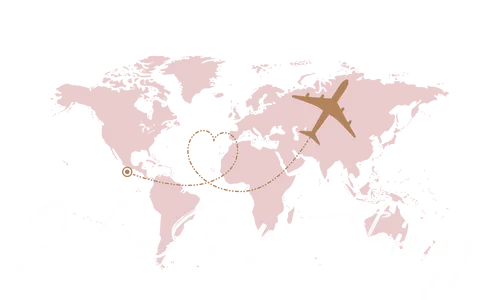
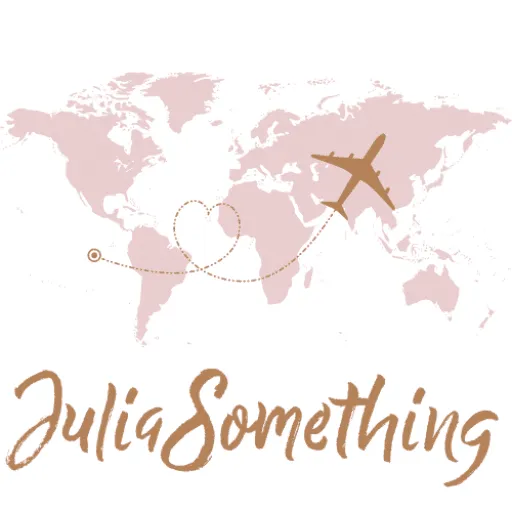





Tell me what you think!